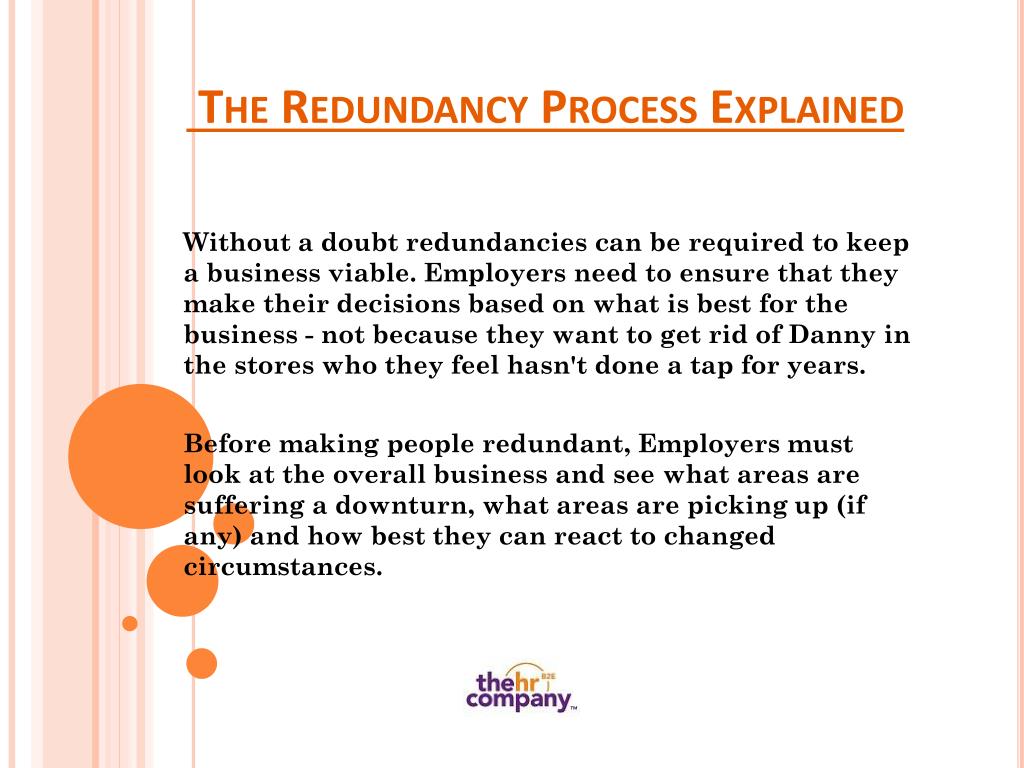If a Company Goes Bust Who Pays Redundancy? Legal Insights for UK Employees
If a Company Goes Bust Who Pays Redundancy? Legal Insights for UK Employees
Blog Article
Discovering the Operational Dynamics of Business Redundancy and Its Long-Term Sustainability

Redundancy Techniques for Organization Continuity
In order to ensure undisturbed procedures, organizations need to implement effective redundancy methods for organization continuity. Redundancy in this context refers to the duplication of important components or functions within a system to alleviate the impact of potential failures. By integrating redundancy methods, organizations can enhance their resilience against interruptions triggered by various variables such as all-natural catastrophes, equipment failings, or cyber-attacks.
One usual redundancy approach is the implementation of back-up systems and information storage options. This includes producing duplicates of necessary data and systems that can be activated in case of a primary system failing. In addition, companies can establish redundant interaction networks and power resources to maintain connectivity and operations throughout unforeseen occasions.
Additionally, cross-training employees to perform multiple duties within the company can function as a valuable redundancy strategy. This makes sure that vital tasks can still be accomplished even if key employees are inaccessible because of disease or other reasons. Generally, effective redundancy approaches are crucial for services to copyright functional continuity and lessen the effect of possible disturbances.
Effect of Redundancy on Business Durability
Given the vital duty redundancy approaches play in making certain service continuity, checking out the influence of redundancy on organizational strength ends up being important for comprehending the holistic operational characteristics of a company. Business resilience describes an entity's ability to adapt to disturbances, recover from troubles, and transform when essential while maintaining core features. Redundancy, when purposefully implemented, can dramatically add to enhancing an organization's strength when faced with unexpected difficulties. By having back-up systems, workers, or processes in place, firms can much better withstand shocks and continue procedures with minimal disruption.
Moreover, redundancy can boost worker morale and confidence, recognizing that there are backup strategies in position to address unexpected scenarios. This complacency can bring about raised productivity and a more positive work environment. Furthermore, redundancy can foster innovation and creative thinking within an organization as workers feel encouraged to take calculated risks, understanding that there is a safety and security web to sustain them in instance of failure. Overall, the influence of redundancy on business strength is profound, shaping the long-term sustainability and success of a firm.
Stabilizing Effectiveness and Adaptability in Redundancy
Attaining an unified equilibrium between operational efficiency and adaptive adaptability is a pivotal challenge in the critical release of redundancy within organizations. Also much versatility without a strong operational structure can result in inefficiencies and variance.
To stabilize performance and adaptability in redundancy preparation, companies should very carefully assess their functional requirements, market characteristics, and calculated objectives. Carrying out lean practices can enhance efficiency by improving processes and eliminating waste, while fostering a culture of flexibility and continual improvement can boost flexibility. Additionally, buying cross-training programs and durable communication channels can aid grow a functional workforce efficient in managing diverse jobs throughout periods of transition. Ultimately, finding the appropriate stability between efficiency and versatility is vital for building a sustainable and resistant company when faced with uncertainty.
Long-Term Sustainability Via Redundancy Preparation
To make sure long-lasting stability and security, companies have to purposefully align their redundancy planning with long-lasting who pays redundancy money sustainability objectives, consequently balancing functional performance with flexible versatility. Firms need to watch redundancy not as a responsive option to instant issues yet as an aggressive strategy for lasting success.

Proactive Steps for Sustainable Business Procedures
Just how can firms proactively boost their functional sustainability for long-term success? Executing proactive measures is essential for firms intending to make sure sustainable procedures.
In addition, cultivating a culture of continuous renovation and understanding within the company can improve adaptability to transforming market conditions and consumer demands. Urging worker involvement in decision-making procedures and supplying opportunities for specialist advancement can boost morale, efficiency, and general performance. Developing clear goals, monitoring crucial efficiency indications, and on a regular basis examining progress are crucial components of aggressive sustainability management.
Working together with suppliers, consumers, and other stakeholders to promote lasting techniques throughout the supply chain can create a surge effect of favorable impact - redundancy pay if company goes bust. By taking aggressive actions towards operational sustainability, firms can build strength, drive development, and safeguard their long-lasting success in an ever-evolving organization landscape
Conclusion

In the world of organizational management, the calculated deployment of firm redundancy stands as a critical yet detailed method that requires a delicate equilibrium in between operational performance and long-term practicality. By dissecting the operational characteristics that underpin company redundancy and reviewing its broader ramifications for business strength and flexibility, a nuanced understanding of how redundancy techniques can form the future trajectory of a firm starts to unfold.Offered the crucial duty redundancy techniques play in making certain business connection, exploring the effect of redundancy on business strength becomes important for understanding the alternative functional characteristics of a company. Generally, the impact of redundancy on business strength is extensive, shaping the long-term sustainability and success of a business.
In final thought, understanding the functional characteristics of firm redundancy is essential for making sure lasting sustainability.
Report this page